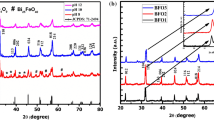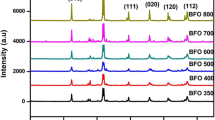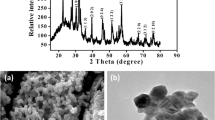Abstract
Herein, we have studied the influence of terbium (Tb) doping in bismuth ferrite (BiFeO3/BFO) nanoparticles towards its photocatalytic activity by varying the concentration of Tb such as Bi1−xTbxFeO3, x = 0, 1, 3, 5% through a simple hydrothermal method. The obtained samples are characterized using XRD, TEM, XPS, and UV–Vis diffuse reflectance spectroscopy and studied their photocatalytic properties by degrading the rhodamine B (RhB) dye molecules under sunlight illumination. The XRD results confirmed a gradual transformation of crystal structure of BFO from rhombohedral to orthorhombic structure with the increasing concentration of Tb. Dopant induced size reduction in particles is confirmed through TEM and the obtained results revealed the average particles size of 5% Tb dopant BFO around 40 to 80 nm for 5% Tb doped BFO. It indicates that the Tb doping in BFO could considerably affect the photocatalytic activity, and accordingly, the photocatalytic performance is gradually enhanced with increasing Tb content up to an optimum level. To understand the improved mechanism of photocatalytic degradation by Tb-doped BFO, the free radicals trapping tests and photoluminescence are carried out. Based on these outcomes, the improved catalytic activity of Tb-doped BFO is attributed to its reduced bandgap energy from 2.35 to 2.29 eV, improved optical absorption profile, the effective charge separation and transfer of photo-induced charge carriers with increased recombination resistance in the system and accordingly, a possible photocatalytic mechanism of Tb-doped BFO is also proposed.






Similar content being viewed by others
References
J.O. Tijani, O.O. Fatoba, G. Madzivire, L.F. Petrik, A review of combined advanced oxidation technologies for the removal of organic pollutants from water. Water Air Soil Pollut. (2014). https://doi.org/10.1007/s11270-014-2102-y
A. Machulek Jr., S.C. Oliveira, M.E. Osugi, V.S. Ferreira, F.H. Quina, R.F. Dantas, S.L. Oliveira, G.A. Casagrande, F.J. Anaissi, V.O. Silva, R.P. Cavalcante, F. Gozzi, D.D. Ramos, A.P.P. da Rosa, A.P.F. Santos, D.C. de Castro, J.A. Nogueira, Application of different advanced oxidation processes for the degradation of organic pollutants. Org. Pollut. Monit. Risk Treat. (2013). https://doi.org/10.5772/53188
M.S.S. Danish, L.L. Estrella, I.M.A. Alemaida, A. Lisin, N. Moiseev, M. Ahmadi, M. Nazari, M. Wali, H. Zaheb, T. Senjyu, Photocatalytic applications of metal oxides for sustainable environmental remediation. Metals (Basel) 11, 1–25 (2021). https://doi.org/10.3390/met11010080
D. Chatterjee, S. Dasgupta, Visible light induced photocatalytic degradation of organic pollutants. J. Photochem. Photobiol. C 6, 186–205 (2005). https://doi.org/10.1016/j.jphotochemrev.2005.09.001
F. Zhang, X. Wang, H. Liu, C. Liu, Y. Wan, Y. Long, Z. Cai, Recent advances and applications of semiconductor photocatalytic technology. Appl. Sci. (2019). https://doi.org/10.3390/app9122489
S.H. Han, K.S. Kim, H.G. Kim, H.G. Lee, H.W. Kang, J.S. Kim, C. Il Cheon, Synthesis and characterization of multiferroic BiFeO3 powders fabricated by hydrothermal method. Ceram. Int. 36, 1365–1372 (2010). https://doi.org/10.1016/j.ceramint.2010.01.020
S. Pearton, Editorial: doped nanostructures. Nanoscale 2, 1057 (2010). https://doi.org/10.1039/c005273f
J. Wu, Z. Fan, D. Xiao, J. Zhu, J. Wang, Multiferroic bismuth ferrite-based materials for multifunctional applications: ceramic bulks, thin films and nanostructures. Prog. Mater. Sci. 84, 335–402 (2016). https://doi.org/10.1016/j.pmatsci.2016.09.001
Y. Subramanian, V. Ramasamy, R.J. Karthikeyan, G.R. Srinivasan, D. Arulmozhi, R.K. Gubendiran, M. Sriramalu, Investigations on the enhanced dye degradation activity of heterogeneous BiFeO3–GdFeO3 nanocomposite photocatalyst. Heliyon (2019). https://doi.org/10.1016/j.heliyon.2019.e01831
X. Kang, S. Liu, Z. Dai, Y. He, X. Song, Z. Tan, Titanium dioxide: from engineering to applications. Catalysts (2019). https://doi.org/10.3390/catal9020191
F. Huang, A. Yan, H. Zhao, Influences of doping on photocatalytic properties of TiO2 photocatalyst (2016). https://doi.org/10.5772/63234
M. Serhan, M. Sprowls, D. Jackemeyer, M. Long, I.D. Perez, W. Maret, N. Tao, E. Forzani, Total iron measurement in human serum with a smartphone. Int. J. Transl. Eng. Health Med. (2019). https://doi.org/10.1109/JTEHM.2020.3005308
S. Irfan, S. Rizwan, Y. Shen, L. Li, A. Asfandiyar, S. Butt, C.W. Nan, The gadolinium (Gd3+) and Tin (Sn4+) Co-doped BiFeO3 nanoparticles as new solar light active photocatalyst. Sci. Rep. 7, 1–12 (2017). https://doi.org/10.1038/srep42493
N. Wang, X. Luo, L. Han, Z. Zhang, R. Zhang, H. Olin, Y. Yang, Structure, performance, and application of BiFeO3 nanomaterials. Nano–Micro Lett. (2020). https://doi.org/10.1007/s40820-020-00420-6
G. Biasotto, A.Z. Simões, C.R. Foschini, M.A. Zaghete, J.A. Varela, E. Longo, Microwave–hydrothermal synthesis of perovskite bismuth ferrite nanoparticles. Mater. Res. Bull. 46, 2543–2547 (2011). https://doi.org/10.1016/j.materresbull.2011.08.010
S. Godara, N. Sinha, G. Ray, B. Kumar, Combined structural, electrical, magnetic and optical characterization of bismuth ferrite nanoparticles synthesized by auto-combustion route. J. Asian Ceram. Soc. 2, 416–421 (2014). https://doi.org/10.1016/j.jascer.2014.09.001
V. Srinivas, A.T. Raghavender, K.V. Kumar, Structural and magnetic properties of Mn doped BiFeO3 nanomaterials. Phys. Res. Int. (2016). https://doi.org/10.1155/2016/4835328
A. Haruna, I. Abdulkadir, S.O. Idris, Photocatalytic activity and doping effects of BiFeO3 nanoparticles in model organic dyes. Heliyon 6, e03237 (2020). https://doi.org/10.1016/j.heliyon.2020.e03237
A. Wrzesinska, A. Khort, I. Bobowska, A. Busiakiewicz, A. Wypych-Puszkarz, Influence of the La3+, Eu3+, and Er3+ doping on structural, optical, and electrical properties of BiFeO3 nanoparticles synthesized by microwave-assisted solution combustion method. J. Nanomater. (2019). https://doi.org/10.1155/2019/5394325
N. Sangiorgi, L. Aversa, R. Tatti, R. Verucchi, A. Sanson, Spectrophotometric method for optical band gap and electronic transitions determination of semiconductor materials. Opt. Mater. (Amst.) 64, 18–25 (2017). https://doi.org/10.1016/j.optmat.2016.11.014
M. Han, J. Jia, W. Wang, Pulsed laser deposition of a Bi2S3/CuInS2/TiO2 cascade structure for high photoelectrochemical performance. RSC Adv. 6, 70952–70959 (2016). https://doi.org/10.1039/c6ra14901d
L.L. Long, A.Y. Zhang, Y.X. Huang, X. Zhang, H.Q. Yu, A robust cocatalyst Pd4S uniformly anchored onto Bi2S3 nanorods for enhanced visible light photocatalysis. J. Mater. Chem. A 3, 4301–4306 (2015). https://doi.org/10.1039/c4ta05818f
A.P. Grosvenor, B.A. Kobe, M.C. Biesinger, N.S. McIntyre, Investigation of multiplet splitting of Fe 2p XPS spectra and bonding in iron compounds. Surf. Interface Anal. 36, 1564–1574 (2004). https://doi.org/10.1002/sia.1984
E. Erasmus, Electronic effects of group fragments on the XPS of Fe 2p and 3p photoelectron lines of ferrocenyl-containing chalcones. S. Afr. J. Chem. 70, 94–99 (2017). https://doi.org/10.17159/0379-4350/2017/v70a13
A. Chatterjee, T. Iwasaki, T. Ebina, Structural and energetic changes of Si (100) surface with fluorine in presence of water—a density functional study. Int. J. Mol. Sci. 2, 40–56 (2001). https://doi.org/10.3390/i2020040
X. Zhuang, Y. Wan, C. Feng, Y. Shen, D. Zhao, Highly efficient adsorption of bulky dye molecules in wastewater on ordered mesoporous carbons. Chem. Mater. 21, 706–716 (2009). https://doi.org/10.1021/cm8028577
J. Ananpattarachai, P. Kajitvichyanukul, S. Seraphin, Visible light absorption ability and photocatalytic oxidation activity of various interstitial N-doped TiO2 prepared from different nitrogen dopants. J. Hazard. Mater. 168, 253–261 (2009). https://doi.org/10.1016/j.jhazmat.2009.02.036
M. Younas, M.A. Gondal, U. Mehmood, K. Harrabi, Z.H. Yamani, F.A. Al-Sulaiman, Performance enhancement of dye-sensitized solar cells via cosensitization of ruthenizer Z907 and organic sensitizer SQ2. Int. J. Energy Res. 42, 3957–3965 (2018). https://doi.org/10.1002/er.4154
H.T. Tung, N.T. Thao, L.Q. Vinh, The reduced recombination and the enhanced lifetime of excited electron in QDSSCs based on different ZnS and SiO2 passivation. Int. J. Photoenergy (2018). https://doi.org/10.1155/2018/8545207
B. Mei, K. Han, G. Mul, Driving surface redox reactions in heterogeneous photocatalysis: the active state of illuminated semiconductor-supported nanoparticles during overall water-splitting. ACS Catal. 8, 9154–9164 (2018). https://doi.org/10.1021/acscatal.8b02215
S. Elhani, H. Ishitobi, Y. Inouye, A. Ono, S. Hayashi, Z. Sekkat, Surface enhanced visible absorption of dye molecules in the near-field of gold nanoparticles. Sci. Rep. 10, 3–5 (2020). https://doi.org/10.1038/s41598-020-60839-0
M.B. Johnston, L.M. Herz, Hybrid perovskites for photovoltaics: charge-carrier recombination, diffusion, and radiative efficiencies. Acc. Chem. Res. 49, 146–154 (2016). https://doi.org/10.1021/acs.accounts.5b00411
M. Rochkind, S. Pasternak, Y. Paz, Using dyes for evaluating photocatalytic properties: a critical review. Molecules 20, 88–110 (2015). https://doi.org/10.3390/molecules20010088
J. Li, N. Wu, Semiconductor-based photocatalysts and photoelectrochemical cells for solar fuel generation: a review. Catal. Sci. Technol. 5, 1360–1384 (2015). https://doi.org/10.1039/c4cy00974f
Y. Nam, J.H. Lim, K.C. Ko, J.Y. Lee, Photocatalytic activity of TiO2 nanoparticles: a theoretical aspect. J. Mater. Chem. A 7, 13833–13859 (2019). https://doi.org/10.1039/c9ta03385h
A. Gnanaprakasam, V.M. Sivakumar, M. Thirumarimurugan, Influencing parameters in the photocatalytic degradation of organic effluent via nanometal oxide catalyst: a review. Indian J. Mater. Sci. 2015, 1–16 (2015). https://doi.org/10.1155/2015/601827
P. Zheng, Z. Pan, H. Li, B. Bai, W. Guan, Effect of different type of scavengers on the photocatalytic removal of copper and cyanide in the presence of TiO2@yeast hybrids. J. Mater. Sci. Mater. Electron. 26, 6399–6410 (2015). https://doi.org/10.1007/s10854-015-3229-3
Y.H. Chiu, T.F.M. Chang, C.Y. Chen, M. Sone, Y.J. Hsu, Mechanistic insights into photodegradation of organic dyes using heterostructure photocatalysts. Catalysts (2019). https://doi.org/10.3390/catal9050430
A. Ajmal, I. Majeed, R.N. Malik, H. Idriss, M.A. Nadeem, Principles and mechanisms of photocatalytic dye degradation on TiO2 based photocatalysts: a comparative overview. RSC Adv. 4, 37003–37026 (2014). https://doi.org/10.1039/c4ra06658h
A. Pavanello, A. Blasco, P.F. Johnston, M.A. Miranda, M.L. Marin, Enhanced photodegradation of synthetic dyes mediated by Ag3PO4-based semiconductors under visible light irradiation. Catalysts (2020). https://doi.org/10.3390/catal10070774
P.A. Riley, Free radicals in biology: oxidative stress and the effects of ionizing radiation. Int. J. Radiat. Biol. 65, 27–33 (1994). https://doi.org/10.1080/09553009414550041
B. Palanivel, A. Mani, Conversion of a Type-II to a Z-Scheme heterojunction by intercalation of a 0D electron mediator between the integrative NiFe2O4/g-C3N4 composite nanoparticles: boosting the radical production for photo-Fenton degradation. ACS Omega 31, 19747–19759 (2020). https://doi.org/10.1021/acsomega.0c02477
B. Palanivel, C. Hu, M. Shkir, S. Alfaify, F.A. Ibrahim, M.S. Hamdy, A. Mani, Fluorine doped g-C3N4 coupled NiFe2O4 heterojunction: consumption of H2O2 for production of hydroxyl radicals towards paracetamol degradation. Colloids Interface Sci. Commun. 42, 100410 (2021). https://doi.org/10.1016/j.colcom.2021.100410
Acknowledgements
Authors thankfully acknowledge the Research Supporting Project (Ref. RSP-2021/160) of King Saud University.
Author information
Authors and Affiliations
Corresponding authors
Additional information
Publisher's Note
Springer Nature remains neutral with regard to jurisdictional claims in published maps and institutional affiliations.
Supplementary Information
Below is the link to the electronic supplementary material.
Rights and permissions
About this article
Cite this article
Pathmanaban, G., Hossain, M.S., Macadangdang, R.R. et al. Effect of terbium doping in bismuth ferrite nanoparticles for the degradation of organic pollutant under sunlight irradiation. J Mater Sci: Mater Electron 33, 9324–9333 (2022). https://doi.org/10.1007/s10854-021-07299-y
Received:
Accepted:
Published:
Issue Date:
DOI: https://doi.org/10.1007/s10854-021-07299-y




